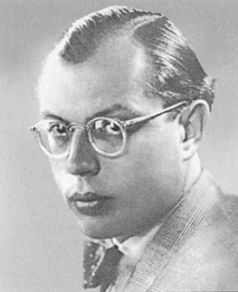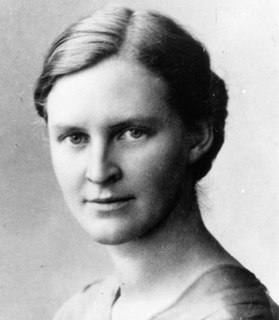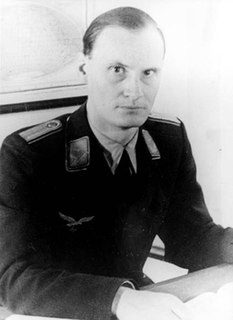Related Research Articles

The history of Germany from 1945–1990 spans the period following World War II during the Division of Germany. The Potsdam Agreement was made between the major winners of World War II on 1 August 1945, in which Germany was separated into spheres of influence during the Cold War between the Western Bloc and Eastern Bloc.

The Red Orchestra, as it was known in Germany, was the name given by the Abwehr Section III.F to anti-Nazi resistance workers in August 1941. It primarily referred to a loose network of resistance groups, connected through personal contacts, uniting hundreds of opponents of the Nazi regime. These included groups of friends who held discussions that were centred on Harro Schulze-Boysen, Adam Kuckhoff and Arvid Harnack in Berlin, alongside many others. They printed and distributed prohibited leaflets, posters, and stickers, hoping to incite civil disobedience. They aided Jews and resistance to escape the regime, documented the atrocities of the Nazis, and transmitted military intelligence to the Allies. Contrary to legend, the Red Orchestra was neither directed by Soviet communists nor under a single leadership. It was a network of groups and individuals, often operating independently. To date, about 400 members are known by name.
UFA GmbH, shortened to UFA, is a film and television production company that unites all production activities of the media conglomerate Bertelsmann in Germany. Its name derives from Universum-Film Aktiengesellschaft, a major German film company headquartered in Babelsberg, producing and distributing motion pictures from 1917 until the end of the Nazi era. The name UFA was revived by Bertelsmann for an otherwise unrelated film and television outfit, UFA GmbH.

Kolberg is a 1945 German historical film directed by Veit Harlan. One of the last films of the Third Reich, it was intended as a Nazi propaganda piece to bolster the will of the German population to resist the Allies.
The Berliner Rundfunk (BERU) was a radio station set in East Germany. It had a political focus and discussed events in East Berlin. Today it is a commercial radio station broadcast with the name "Berliner Rundfunk 91.4".

Rudolf "Dolf" von Scheliha was a German aristocrat, cavalry officer and diplomat who became a resistance fighter and anti-Nazi who was linked to the Red Orchestra. Von Scheliha fought in the World War I and this experience defined his politics. He joined the Foreign Office, trained to be a diplomat and was sent to the embassy in Warsaw. In the years leading up to the war, Von Scheliha was placed in a position of trust in the Foreign Office. In 1934, he was recruited by Soviet intelligence while he served in Warsaw due to financial necessity, which enabled him to pass documents to Soviet intelligence. In the years leading up to the war, he became a committed opponent of the Nazi Regime and its anti-semitic policies.

Arvid Harnack was a German jurist, Marxist economist, Communist, and German resistance fighter in Nazi Germany. Harnack came from an intellectual family and was originally a humanist. He was strongly influenced by Johann Wolfgang von Goethe but progressively moved to a Marxist-Socialist outlook after a visit to the Soviet Union and the Nazis' appearance. After starting an undercover discussion group based at the Berlin Abendgymnasium, he met Harro Schulze-Boysen, who ran a similar faction. Like numerous groups in other parts of the world, the undercover political factions led by Harnack and Schulze-Boysen later developed into an espionage network that supplied military and economic intelligence to the Soviet Union. The group was later called the Red Orchestra by the Abwehr. He and his American-born wife, Mildred Harnack, were executed by the Nazi regime in 1942 and 1943, respectively.

Mildred "Mili" Elizabeth Fish-Harnack was an American literary historian, author, translator, and member of the German resistance against the Nazi regime. After marrying Arvid Harnack, she moved with him to Germany, where she began her career as an academic. Fish-Harnack spent a year at the University of Jena and the University of Giessen working on her doctoral thesis. At Giessen, she witnessed the beginnings of Nazism. In 1930, the couple moved to Berlin and Fish-Harnack became an assistant lecturer in English and American literature at the University of Berlin. In the early 1930s, the couple became increasingly interested in the Soviet communist system. Harnack established a writers' group that studied the Soviet planned economy, and the couple were able to arrange a visit to the Soviet Union during August 1932 and by 1933 they were fully committed to Soviet ideology. Through contacts at the American embassy, Fish-Harnack became friends with Martha Dodd, who became a part of her salon where they discussed current affairs. In 1936, Fish-Harnack's translation of Irving Stone's biography of Vincent van Gogh, Lust for Life, was published.

Heinz Harro Max Wilhelm Georg Schulze-Boysen was a left-wing German publicist and Luftwaffe officer during World War II. Schulze-Boysen became a leading German resistance fighter against the Nazi regime. He was a member of a Berlin anti-fascist resistance group that was later called the Red Orchestra by the Abwehr. He was arrested and executed in 1942.

Libertas "Libs" Schulze-Boysen, born Libertas Viktoria Haas-Heye was a German aristocrat and resistance fighter against the Nazis. From the early 1930s to 1940, Libs attempted to build a literary career, initially as a press officer and later as a writer and journalist. Initially sympathetic to the Nazis as her family had close links to the most senior levels of the regime, she changed her mind after meeting and marrying Luftwaffe officer Harro Schulze-Boysen.

Following the collapse and defeat of Nazi Germany in World War II, the victorious Allies asserted joint authority and sovereignty over Germany as a whole, collectively known as Allied-occupied Germany, defined as all territories of the former German Reich west of the Oder–Neisse line, having declared the destruction of Nazi Germany at the death of Adolf Hitler. The four powers divided "Germany as a whole" into four occupation zones for administrative purposes under the three Western Allies and the Soviet Union, respectively. This division was ratified at the August 1945 Potsdam Conference. The four zones were agreed by the United States, United Kingdom and Soviet Union at the February 1945 Yalta Conference, setting aside an earlier division into three zones proposed by the September 1944 London Protocol.
The legal status of Germany concerns the question of the extinction, or otherwise continuation, of the German nation state following the rise and downfall of Nazi Germany, and constitutional hiatus of the military occupation of Germany by the four Allied powers from 1945 to 1949. It became current once again when the German Democratic Republic joined the Federal Republic of Germany in 1990.

The Harnack House in the Dahlem district of Berlin, Germany was opened in 1929 as a centre for German scientific and intellectual life. Located in the intellectual colony of Dahlem, seat of the Free University Berlin, it was founded by the Kaiser Wilhelm Gesellschaft (KWG) on the initiative of its first president, the theologian Adolf von Harnack, and of its then chairman, Friedrich Glum. The project was supported politically by the Weimar Republic Chancellor Wilhelm Marx and Foreign Minister Gustav Stresemann, and an influential Centre Party deputy Georg Schreiber. The land for its construction was donated by the state of Prussia, and the costs of building and furnishing the house were defrayed partly by the government, and partly by public subscription.
The Berlin Declaration of 5 June 1945, had the governments of the United States, the Soviet Union, the United Kingdom and France, acting on behalf of the Allies of World War II, jointly assume "supreme authority" over German territory and asserted the legitimacy of their joint determination of issues regarding its administration and boundaries prior to the forthcoming Potsdam Conference.

The German Federal Archives or Bundesarchiv (BArch) are the National Archives of Germany. They were established at the current location in Koblenz in 1952.
The Staatliches Filmarchiv der DDR (SFA) was the central film archive of the GDR.

Günther Weisenborn was a German writer and fighter in the German Resistance against Nazism. He was notable for collaborating with Bertolt Brecht, along with Hanns Eisler, Slatan Dudow, on the play, The Mother. However, in 1933, when the work fell out of favour by the Nazis after being blacklisted by Joseph Goebbels, he emigrated to Argentina. When he returned in 1937, be became a member of a Berlin-based, resistance group that was later renamed to the Red Orchestra by the Abwehr. He was arrested in 1942 and sentenced to several years in prison, he was released in 1945 by Soviet troops.

Greta Kuckhoff was a Resistance member in Nazi Germany, who belonged to the illegal Communist Party of Germany and the NKVD spy ring that was dubbed the Red Orchestra by the Abwehr. She was married to Adam Kuckhoff, who was executed by the Third Reich. After the war, she lived in the German Democratic Republic, where she was president of Deutsche Notenbank from 1950 to 1958.

Karl Behrens was a design engineer and resistance fighter against Nazism. Behrens was most notable for being a member of the Berlin-based anti-fascist resistance group, that was later called the Red Orchestra by the Abwehr. Behrens acted as a courier for the group, passing reports between Arvid Harnack and Hans Coppi who was the radioman. Behrens was also active in a resistance group at the AEG turbine factory power together with Walter Homann and others.
Erna Frida Eifler was a German steno typist secretary who became a communist, resistance fighter, Soviet GRU agent and courier. In 1942, Eifler along with GRU agent Wilhelm Fellendorf were trained by Soviet intelligence in sabotage, wireless telegraphy and parachuting. In May 1942, they were both parachuted into East Prussia by a Russian bomber, with separate missions to contact members of the Berlin-based Red Orchestra and conduct spying operations. Unable to complete their seperate missions, they travelled to Hamburg where they were first hidden by Fellendorf's mother. There they made contact with Bernhard Bästlein and hid at the safehouse of Viktor Priess. The couple were eventually arrested by the Gestapo. After completing a Funkspiel operation, Eifler was sent to Ravensbrück concentration camp where she was executed.